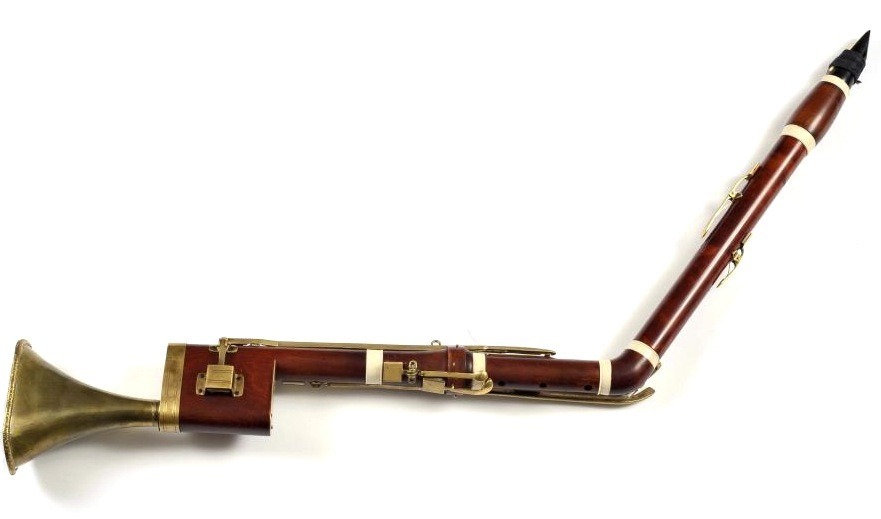Basset horn
Missing Infobox musical instrument / Maintenance / sound parameters example: template
The basset horn is the representative of the tenor in the clarinet family. It transposed to F, so sounds a fifth lower than written. Usually, his part is written in treble clef, even deep Bassetthornstimmen found in older works in the bass clef. This, however, should sound a fourth higher than written, so must be used by the musician octave up.
Construction
The basset horn is like the clarinet of five parts, which, apart from the S- arc that connects the mouth with pear instead of the top piece, also bear the same name. The bell is made of metal and modern instruments in "pipes form " upward as the bass clarinet. ( The figure at right shows an older instrument from the 19th century). The mechanism can be built either by the Boehm system or in German fingering. It differs significantly from that of the basset clarinet.
History
Around 1760 the first basset horns were built at that time in different moods from D to G. Since the lower tuning required a longer column of air, the first instruments were made in the form of a semicircle, so that they were easy to handle despite its length. It is likely that the name of Bassett - Horn on the one hand results from that characteristic shape, on the other hand from the metal bell, which had not the clarinet. A further extension of the tube was coiled and mounted in a block of wood at the bottom of the basset horn.
Later, the round shape was abandoned in favor of an angled design of two straight parts and the flap system developed in parallel on the clarinet mechanics. A short-lived hybrid between basset horn and clarinet was the basset clarinet in A, for the Mozart Clarinet Concerto originally composed; it was invented by Anton Stadler, a friend of Mozart. He expanded the normal clarinet four lower tones, namely Dis, D, C # and C.
The stretched, straight configuration, showing the picture on the right, began at the beginning of the 19th century to enforce. At the same time, the instrument experienced in these decades a devaluation, on the one hand because it was too quiet for the romantic orchestra, on the other hand, because the bass clarinet began to enforce. Apart from Richard Strauss, who began very much like the "old fashioned" basset horn, the instrument fell into oblivion and was revived at the end of the 20th century. This happened to one in conjunction with the historical performance practice, but also with the emerging literature for clarinet quartet ( two clarinets, basset horn and bass clarinet).
Use
The peculiar sound of the basset horn, which is darker, more tender and more miscible than that of the clarinet, was used by only a few composers.
Have especially loved it to but Wolfgang Amadeus Mozart, and duos, three -part Canzonettas for voice and basset horns composed next Bassetthorntrios ( Divertimenti, KV439b ) and like started in the orchestra for religious content: In Requiem, it contributes to the dark orchestral color in and in the Magic it is associated with Sarastro and his priests. In Mozart's opera La Clemenza di Tito 's aria Vitellia (No. 23) Non più dei fiori is composed with konzertierendem solo basset horn. Other solo performances from the classical era exist by Alessandro Rolla, Carl Stamitz and Heinrich oven.
Felix Mendelssohn Bartholdy composed two delightful concert pieces for clarinet, basset horn and piano, and Richard Strauss used the instrument in some of his operas and chamber music in the fan -in. Hartmut Schmidt edited the English horn voice of his Englischornquartetts for basset horn, basset horn will continue in his post box stories used for the characterization of the frog, the piece: "Some Landler " for 2 clarinets and bassoon was processed for 3 basset horns.
As an example for the renaissance of the instrument end of the 20th century are the works that Markus Stockhausen for the musician Tara Bouman composed ( " TARA for basset horn solo", " PORTRAIT FOR TARA - for basset horn and ensemble "). His father Karlheinz Stockhausen used the basset horn, among other things, on the stage as a figure of "EVA " in his light - opera cycle.










